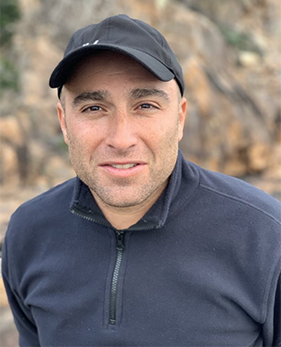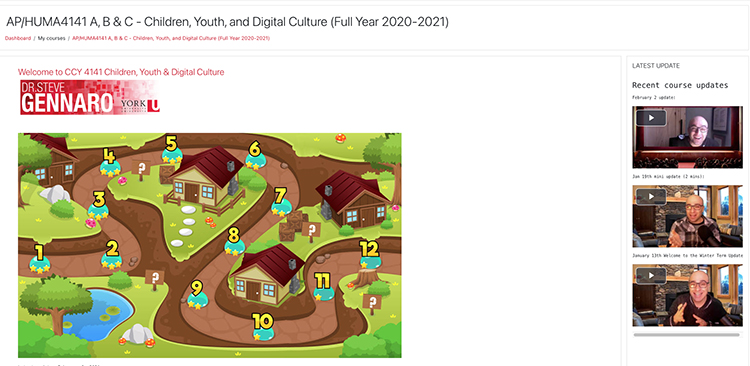Beenish Quddus never envisioned herself using computer code to make characters move in the online game, Minecraft, but that’s exactly what the mature York University international student found herself doing for her class, Children, Youth & Digital Culture.
“We all have coding exercises, but I chose to use Minecraft because my children play it a lot,” said Quddus. “It broadens your horizons on how things work.”

The fourth-year Liberal Arts & Professional Studies (LA&PS) course, AP/HUMA 4141, taught by Steve Gennaro, is a gamified course that explores the lives of young people and their culture in and across digital spaces by offering students a cutting-edge opportunity to understand digital life themselves and to tailor the course material to their interests and the class schedule to their needs.
Gennaro is a lecturer and course director in Communications and in Children, Childhood & Youth in LA&PS, and the instructional designer for the Faculty’s Office of the Dean. He was an early adopter of online learning in the post-secondary context and has been designing and delivering courses in blended, fully online, experiential and gamified formats since as far back as 2005. This fully gamified course is a new addition to his portfolio, brought to fruition by the necessity for increasing student engagement in remote course delivery during the pandemic.
“As a learning designer, I’ve found a lot of interest from faculty in gamification,” Gennaro said. “We know that it creates incredibly strong engagement.”
Gennaro can point to AP/HUMA 4141 as an example. He has designed the course in a non-linear, self-directed game style. When students log in, they find a map that offers them various sites to visit. During the full-year course, students can choose the order and timing of those visits. At each site, they find a series of tasks to do. They can review the tasks, decide which they choose to undertake and when to submit completed work and, finally, they can assign a points value to each task – the percentage of their task grade that each chosen task will represent. Tasks include everything from reflecting on selected readings to creating blogs, photo essays, videos, magazines, board games or podcasts.
“The course is student-driven and co-constructed,” Gennaro said. “This course lets the student choose their own adventure – and this is pushing how we conceptualize the student experience in higher education.”

That’s not to say that Gennaro is hands-off during the process – far from it. He asks each student to develop an individual learning plan and meets with them regularly to see how it is working for them. He creates weekly video messages for the class and provides a walk-in clinic: daily hours when he’ll be at his computer, ready to chat with students on Zoom. The waiting room might be empty or it might be full, but waiting students all get a chance to have a one-on-one conversation with Gennaro.
“Teaching a non-linear course requires a commitment to be readily available and visible to students; it’s easy for them to get lost otherwise,” Gennaro said. “I want to be there for them, and I seek them out if I haven’t heard from them for a while, letting them know I’m here to support them.
“My goal is for them to do well in the course and I tell them to use me as a resource.”
He has also created what he calls “checkpoints” – four two-week periods during the year when students are required to work together on a group project. It helps keep the students on track and offers them an opportunity for interaction with their peers.
For example, one checkpoint brings students together to review statistics about youth and the time they spend online and watch a series of TED Talks about the experiences that girls have with coding and the need for increased access for girls to STEM globally. Students are required to complete an hour of coding themselves, such as Quddus’ work with Minecraft; then, each student must record a mini-TED Talk about their own coding experience and share it with their group. Ultimately, one member of the group creates a video for the group to display to the entire class.
The stages to complete checkpoints are repeated and each checkpoint builds on previous checkpoint material. “I give them low-stakes opportunities to test out ideas in a safe space. They can make mistakes so they can build knowledge and skills for when they are assessed on those same skills and knowledge later in the course.”
“I include hard skills (knowledge, inquiry, application) and soft skills (empathy, creativity, and critical thinking) in the evaluation and rubric,” Gennaro said. “The process is all very transparent. It is designed so students have ownership over their learning and feel a sense of trust. There are no surprises; they know what’s expected.”
Kate Moo King-Curtis, another student in the course, has found the flexible deadlines challenging, because it’s easy to postpone deliverables. Despite the time management challenges, she is delighted to be taking the course.
“Professor Gennaro is doing really excellent things with this platform,” she said. “The group work has kept people connected throughout the year.”
“I like pushing the parameters of learning,” said King-Curtis, who is creating a podcast as one of her deliverables.
“I’d heard rave reviews about Professor Gennaro and I wish I’d had him as a teacher once a year. He’s very creative, innovative and engaging and he’s so passionate and full of energy; it really comes across online.”
Quddus is impressed with Gennaro’s availability to the class.
“Although the course is fully online, Steve is always available through his walk-in clinics or open Zoom sessions,” she said. “We can talk to him, and he makes sure he replies to all emails. The videos he uploads often answer questions he thinks are applicable to all of us. Basically, he’s kept everyone in the loop and I really like the way he’s done things.”
So impressed, in fact, that she has nominated Gennaro for the Dean’s Award of Excellence for his efforts at keeping students’ morale high during the pandemic.
“He has always been present for his students and concerned for their academic, as well as mental wellbeing,” she noted. “Not many professors are engaging with students the way he is.”
For Gennaro, the goal is student success and for this, engagement is of the highest importance. And this is what motivates him to continue to push boundaries in pedagogy and create learning spaces like AP/HUMA 4141 in a gamified, non-linear and choose-your-own-adventure format.
“The feedback I get is that students appreciate the freedom and flexibility, especially during the pandemic,” he said. “The work they are producing is phenomenal and they are passionate about it. They are active agents in their own learning and are taking ownership of it. It is beautiful to be a part of.”
By Elaine Smith, special contributing writer to Innovatus
Originally posted in Yfile
